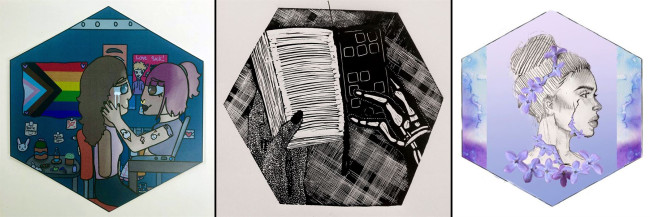Hexagon Project celebrates 15 years of activist artwork with Scranton exhibit on Sept. 10

From a press release:
If the years 2020 and 2021 have taught people anything, they have reminded everyone of the importance of community and the reassurance that, even when they cannot gather in person, they are able to experience the power of connection with others through technology.
The Interdependence Hexagon Project, like so many nonprofits, businesses, and individuals, experienced some challenges due to the pandemic, but art is still alive and well and will be showcased in Scranton this month, celebrating 15 years of its mission to spread the meaning of interdependence through school- and community-created hexagons featuring themes of social justice, identity, peace, and the environment.
Over the past year and a half, many teachers sent regrets that they just could not participate to the chaos with remote, face-to-face, and hybrid teaching, and Nepali could not join in due to the devastating conditions caused by COVID-19.
“It is with great pride and enthusiasm, however, that we present our show this year with understandably less participation, but with the same quality and creative energy as ever! We are so grateful to teachers who continue to give young people the opportunity to voice the concerns they hold in their hearts and to make them visible on our hexagonal canvasses!” said Beth Burkhauser, director of the Hexagon Project and an instructor at Keystone College.
The Eastern Regional Exhibition will open at The Garden Mediterranean Café (116 N. Washington Ave., Scranton) on Friday, Sept. 10 at 11 a.m. and run through Thursday, Sept. 30.
The exhibit will showcase 50 Eastern Regional hexagons, along with a slideshow of all of the 2021 national and international hexagons on a large TV monitor. The pieces on display by 2021 participating artists showcase the year’s themes of diversity/equity and social justice and technology. The public is invited to browse the exhibit throughout the day, but reservations are required for dining. The venue is BYOB.
As an added bonus at this year’s exhibit, the Hexagon Project has partnered with the Scranton Sunday Times and its popular coloring contest with a specially designed hexagon by staff artist Kevin O’Neil. All of the coloring contest entries, in four age categories, will be exhibited, and the winning hexagon artists will be given certificates.
Social change is inspired by a variety of art forms, including music.
While the beautiful hexagons on display speak volumes on their own, it seems an ideal pairing at this year’s exhibit to also feature the music of Scranton native Drew Kelly, who has been heavily influenced by early Bob Dylan and Woody Guthrie. Both are folk artists who sang about issues that raised social consciousness and put a spotlight on the need for interdependence.
Drew Kelly will perform his original songs at the Sept. 10 exhibit from 5:30 p.m.-8:30 p.m.
In July, Drew released his latest album, “From a Deep Abyss.” Inspired by love, fatherhood, sobriety, imaginative storytelling, and contemporary consciousness, the new record takes the listener on a lyrical journey to where he is today, as he considers himself solely a songwriter.
The celebration continues on Sunday, Sept. 12, which is Interdependence Day, when the Hexagon Project will host a worldwide Zoom Recognition Event at 2 p.m.
Scranton Mayor Paige Cognetti will offer a proclamation in celebration of the Hexagon Project’s 15 years. There will be a presentation featuring each of the worldwide recognized hexagons, the 2022 Hexagon Project will be launched with announcement of the year’s special theme, and a motivating address will be given by the co-founder of the Interdependence Movement, Mrs. Sondra Myers, Senior Fellow for International, Civic, and Cultural Projects at the University of Scranton.
All educators, locally and from around the world, are invited and encouraged to participate in the upcoming 2022 Hexagon Project to be part of something powerful that helps students learn lessons that go far beyond art and puts art into action.
The Hexagon Project has its roots in the Interdependence Movement, which was started in Philadelphia by Benjamin R. Barber, Senior Research Scholar at the Center on Philanthropy and Civil Society of the Graduate Center, the City University of New York; author of “Jihad vs. McWorld;” and founder of the Global Parliament of Mayors. After Sept. 11, 2001, Barber and a group of intellectuals, political leaders, and artists from several countries wrote a declaration of interdependence in 2003 and founded Interdependence Day to be held each year on Sept. 12. The movement aims to raise awareness about the interdependent nature of global society and seek trans-national cooperative solutions to global challenges.
Independence used to be the ticket for liberty. But today, security and freedom, whether it’s in the Arab Spring, whether it’s in Iraq, or whether it’s here in the United States, means working cooperatively and interdependently with others.
A significant contributor to this movement, Sondra Myers, co-editor of “The Interdependence Handbook,” invited Elizabeth Burkhauser to join the movement during its yearly celebration in 2006. The Interdependence Hexagon Project began that same year with the aim of promoting the ideals of interdependence and global citizenship through visual arts. The hexagon was chosen as a metaphor for interconnectedness, and works later expanded to using art for social action, activism, and education.
 |



